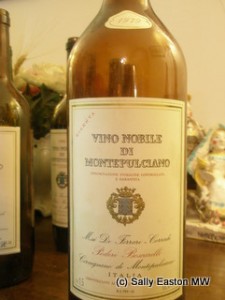Poderi Boscarelli – a 20 year retrospective

Luca De Ferrari Corradi
As part of the anteprima/en primeur tastings in Tuscany during February 2011, Poderi Boscarelli hosted a 20-year retrospective of their wines.
Poderi Boscarelli has been owned by the De Ferrari-Corradi family since 1962, when it was bought by the grandfather of the current generation, brothers Luca and Nicolò.
The estate, situated around 300m above sea level on the hill of Cervognano, has 14 hectares under vine. Sangiovese makes up 80% of the plantings; the rest is planted to local reds mammolo, canaiolo and colorino, with a bit of merlot and cabernet sauvignon.
Their first vintage was in 1965 and from the 1968 vintage they started bottling under their own label.
During the tasting Luca explained the evolution of the Boscarelli style, some of it reflecting wider trends at the time, for example, in the first two wines there were some bunches of white grapes, but by 1988 the family had stopped using white grapes.
Fermentation vessels have changed from concrete in the 70s and 80s, through stainless steel in the 90s and, from the 2001 vintage, in large, 40 hectolitre barrels. By now the family has accumulated 10 of these big casks.
Vintage 2001 was a turning point for yeast, as well. The vintage marked a return to natural yeast after a decade of using cultured yeasts. Luca said “we went back to natural yeast because the 2000 was very difficult to finish the fermentation. By the end of April the fermentation was yet to finish.” They felt natural yeast was more reliable to see fermentation through.
Half the estate’s production is devoted to the ‘straight’ Nobile, and this provided the focus of the tasting, with the exception of the first wine. The Nobile is completely classic, comprising 88% to 90% sangiovese with canaiolo, mammolo, colorino; aged for 24 months in oak. They may make 45 to 50,000 bottles of this, or they may make just 8 to 10,000 bottles, depending on the vintage.
Luca said “we had planted merlot as a curiosity because it was fashionable [in the 90s], and we wanted to make a richer wine, with more oak, and more [immediately] pleasurable.” And so some merlot used to be used in the straight Nobile, but “from 2001, we went back to a traditional Nobile, with more elegance and more acidity”. This fits more with their philosophy of wanting to show the elegance and freshness of acidity of sangiovese.

The '79 magnum
But, Luca explained “at the beginning of the 90s, the wine was often closed in the bouquet, and with not enough colour. Cabernet sauvignon and merlot helped the wine to be more open. You did not have to wait half an hour for the wine to open up. We used small oak on the cabernet sauvignon because it can stand more oak than sangiovese.” And, he added, “this is why we have gone back to using big casks and less new oak, because oak covers the sangiovese, and with too much oxygen [through the oak], sangiovese suffers.” The wines showed it doesn’t take much cabernet sauvignon and merlot to knock sangiovese’s profile off kilter. The 2001 is a welcome return to the purity of a traditional expression.
The riserva is a different style “more international” said Luca, “it tastes different”. The riserva continues to absorb a little international merlot (7%) and cabernet sauvignon (3%) in its profile, with 90% being sangiovese, and it is aged for three years in oak. Luca said “it has more power, more oak, and a little less sangiovese character, with merlot and cabernet sauvignon.”
Produced only in top vintages is Nocio dei Boscarelli, a single vineyard wine, solely from sangiovese, from the vineyard of the walnut tree. The sandy clay soil of this vineyard gives more silky tannins in the wine.
The vineyards have seen their own changes. Replanting started in the late 1980s, with a selection of old clones from their grandfather’s old vineyards, and new clones. Luca said “we have one third clones from our grandfather, one third from Montalcino and one third from Chianti Classico massale selection.” Density almost doubled to the current 7,000 vines per hectare, which means yield can be restricted to around 1kg/vine.
Maurizio Castelli has long been the family’s oenologist.
Tasting notes, in situ, February 2011
Vino Nobile di Montepulciano Riserva 1979, from magnum
Medium colour, mahogany rim. Nose of mahogany, tertiary notes, fruitcake and dried earth. Very smooth character, warm and savoury, casserole meaty. Rich and warming, a rewarding experience to taste.
Vino Nobile di Montepulciano 1983
Medium deep with orange rim. Still primary fruit here, bright red fruits, obviously very mellow and relaxed, with caulky tannins, medium bodied, freshly balanced still, rather delicious. Mellow but still with spine. vg.
Vino Nobile di Montepulciano 1988
Medium deep, not too aromatic on the nose, but spicy, black and aromatic tar on the palate, with a warm baked earth sort of texture, and rich, warmly embracing structure. Sweet baked berry fruit with the patina of graceful age. Lovely, with still a bit of grip.
Vino Nobile di Montepulciano 1991
Medium deep, bricking rim. Wood smoke and baked earth nose, Dundee cake, smooth, sweet tannins, embracing palate again, with fine grainy tannins still framing the whole. Supple core, still fresh, with a slightly fuller rounder body.
Vino Nobile di Montepulciano 1995
Medium deep, bricking rim. Smoke and fruitcake, warm and nearly full bodied. Chocolatey and blanketing in a warm, cuddly way. Rich with warm, sweet, enveloping developed fruit. Perhaps less fresh than the 1980s.
Vino Nobile di Montepulciano 1997
Medium deep, hint of bricking. Five spice and aromatic tar, chocolate and smooth texture, velvet texture, rich and mouth-filling. Medium body, with framing tannins.
Vino Nobile di Montepulciano 1999
Medium deep, overtly tarry, with supple, brambly flavours. The least interesting for me.
Vino Nobile di Montepulciano 2001
Fresh, hint of lifting morello cherry volatile acidity. Silky tannin texture, and lots of tannin in this medium bodied with which has big flavour and intensity and an integrity to its balance. Refreshing, very fine tannins, youthful and delicious. Vg.



